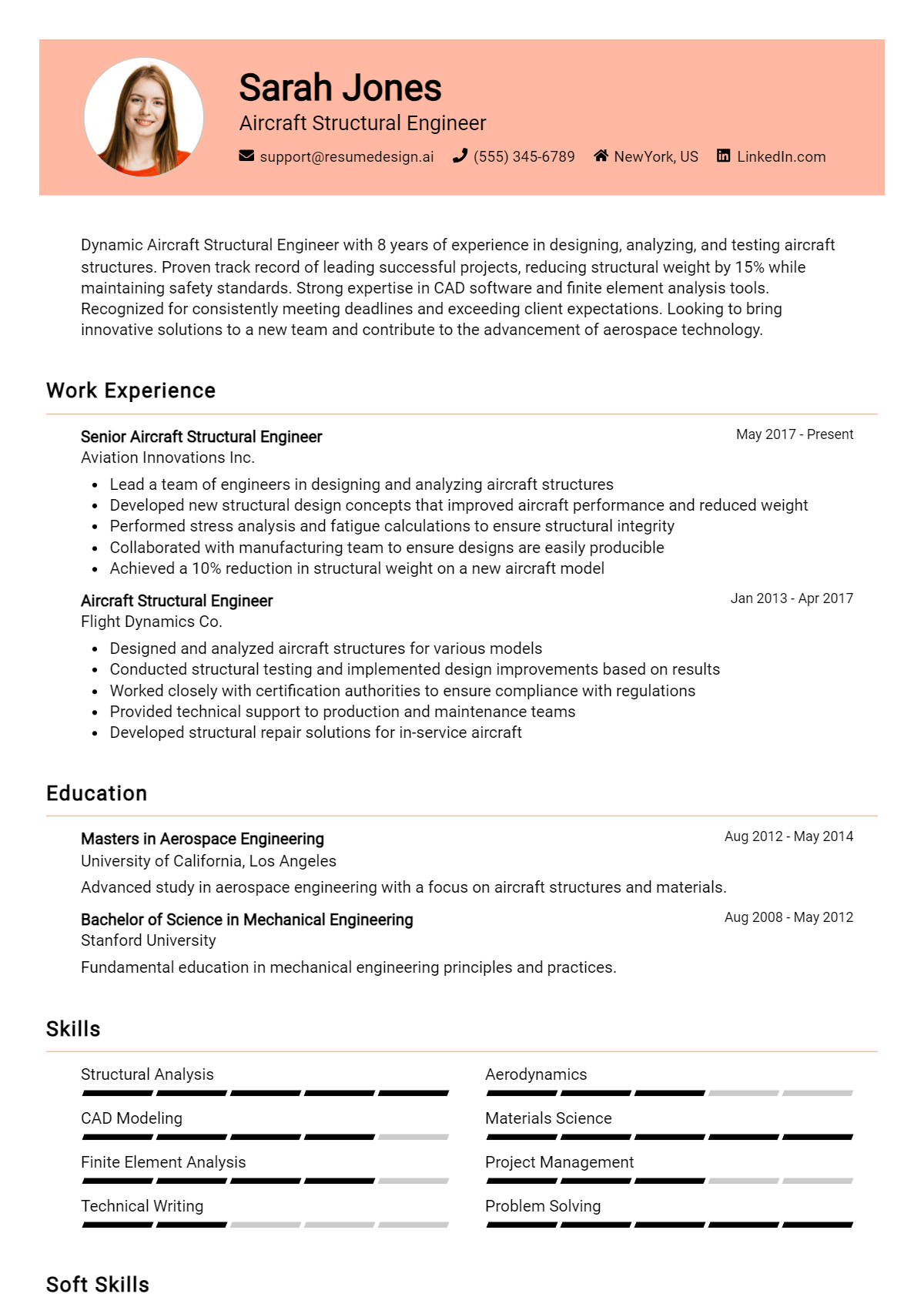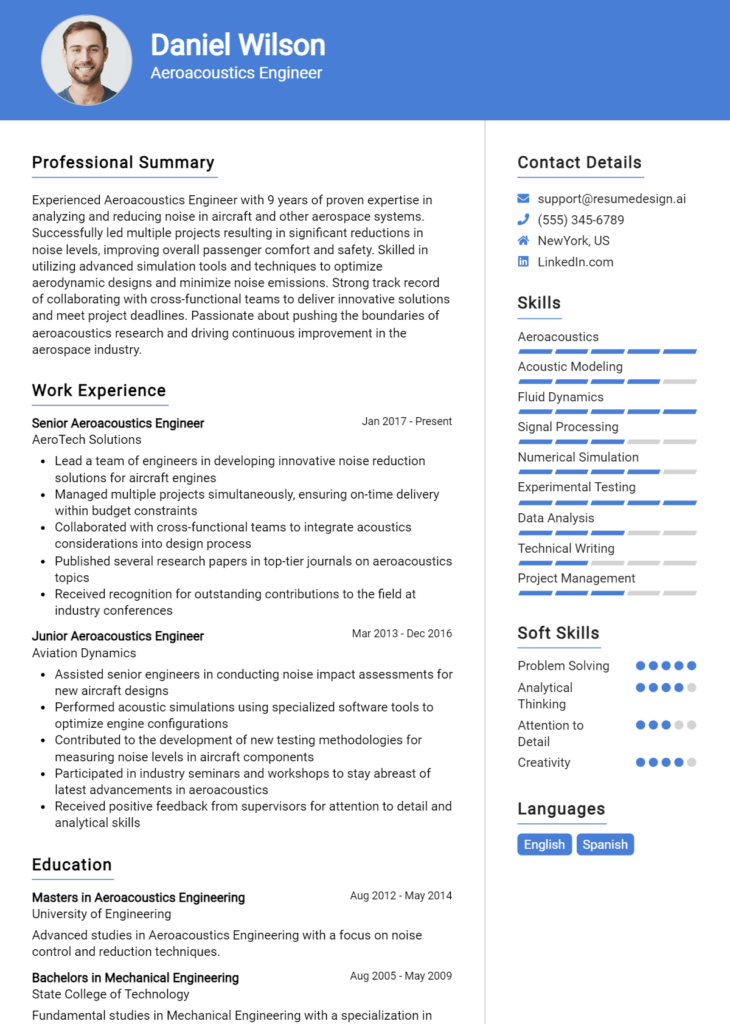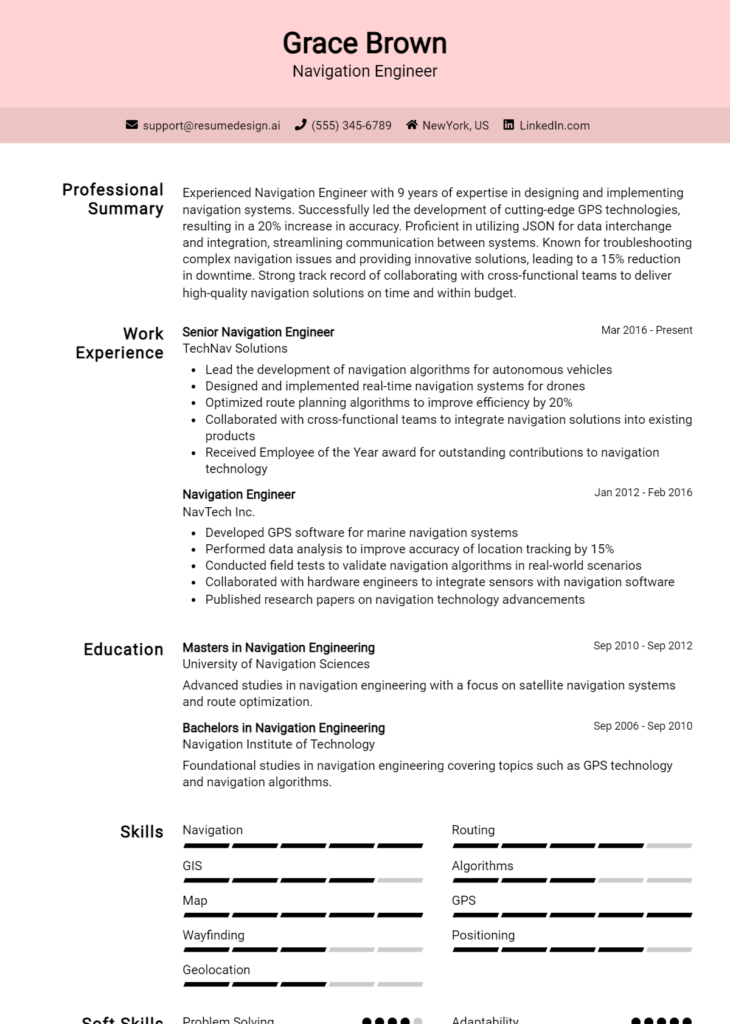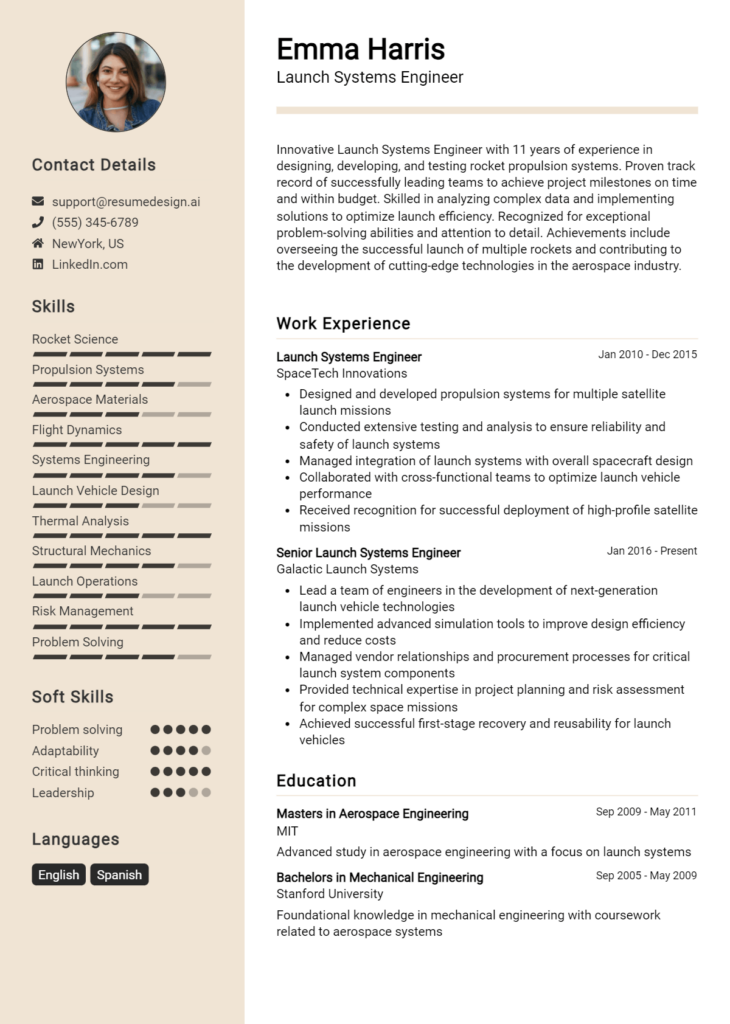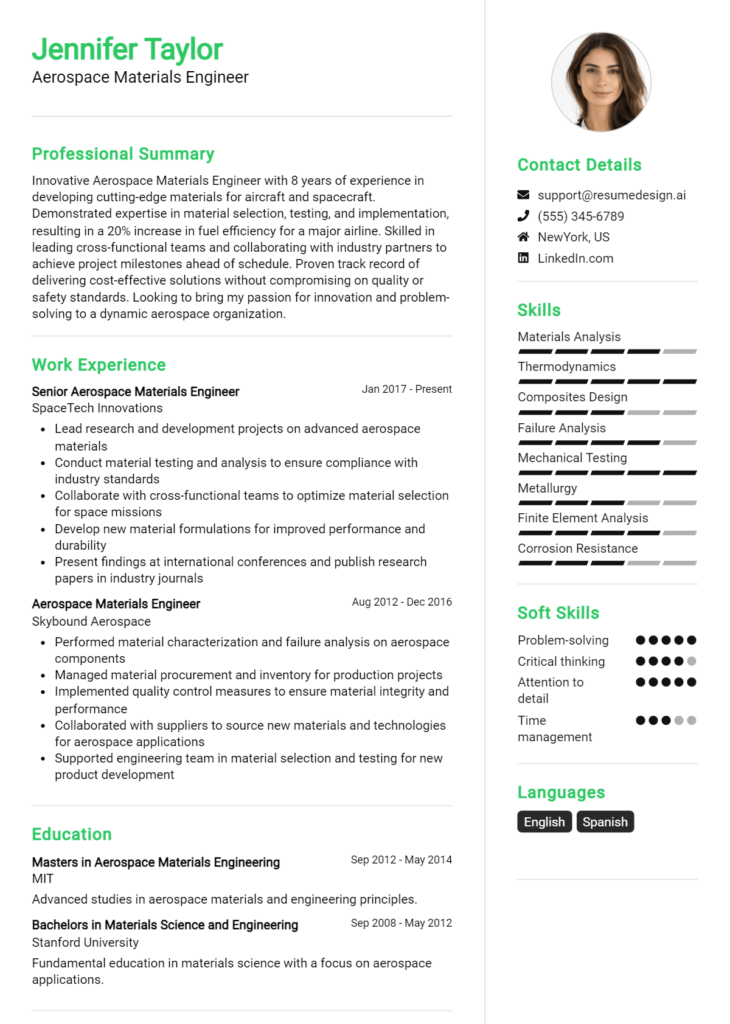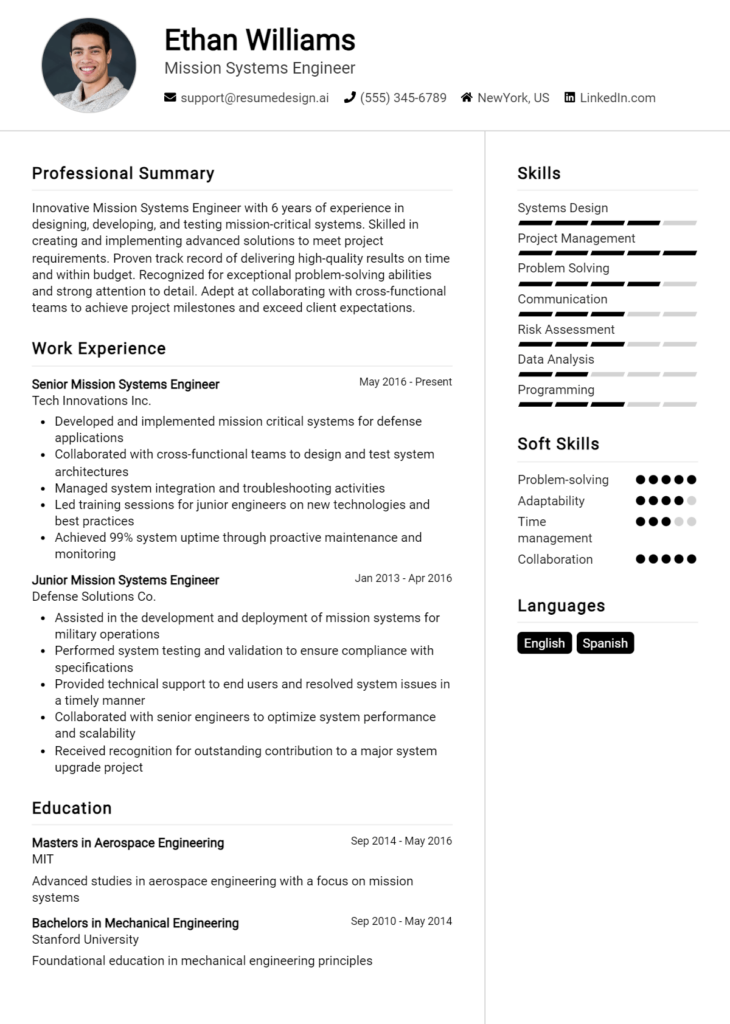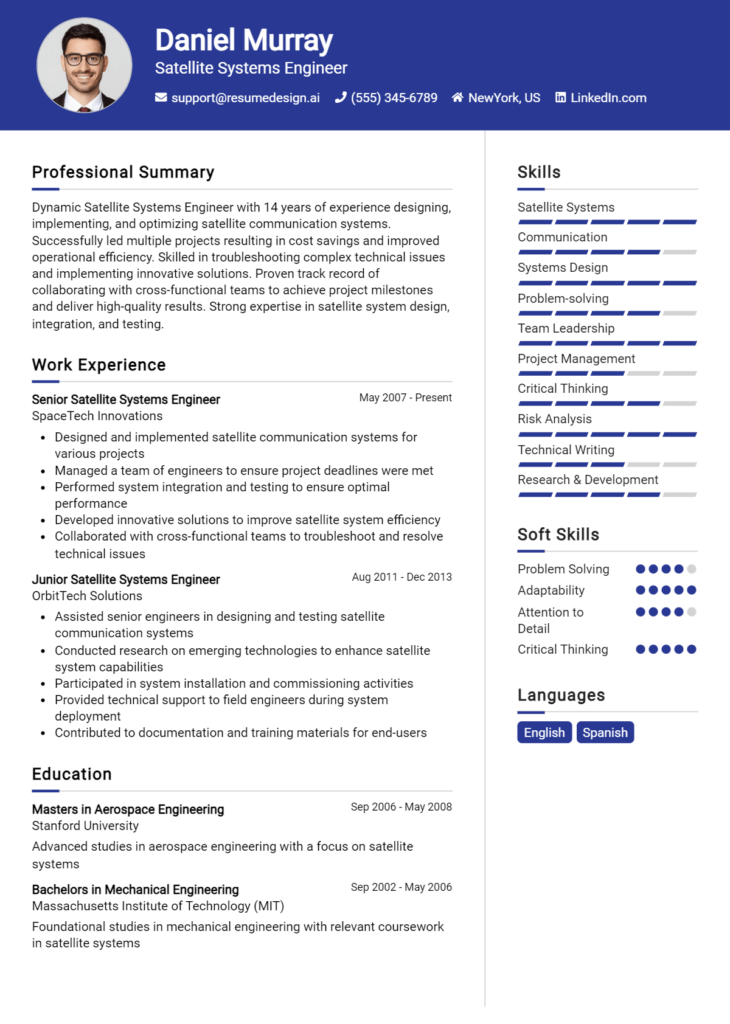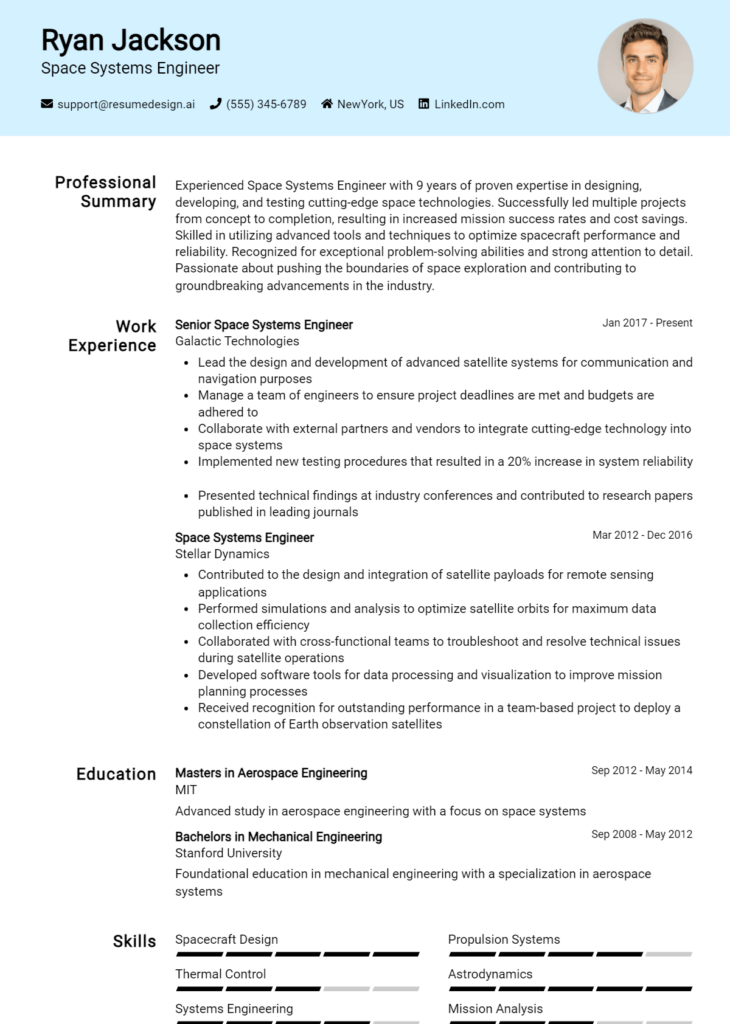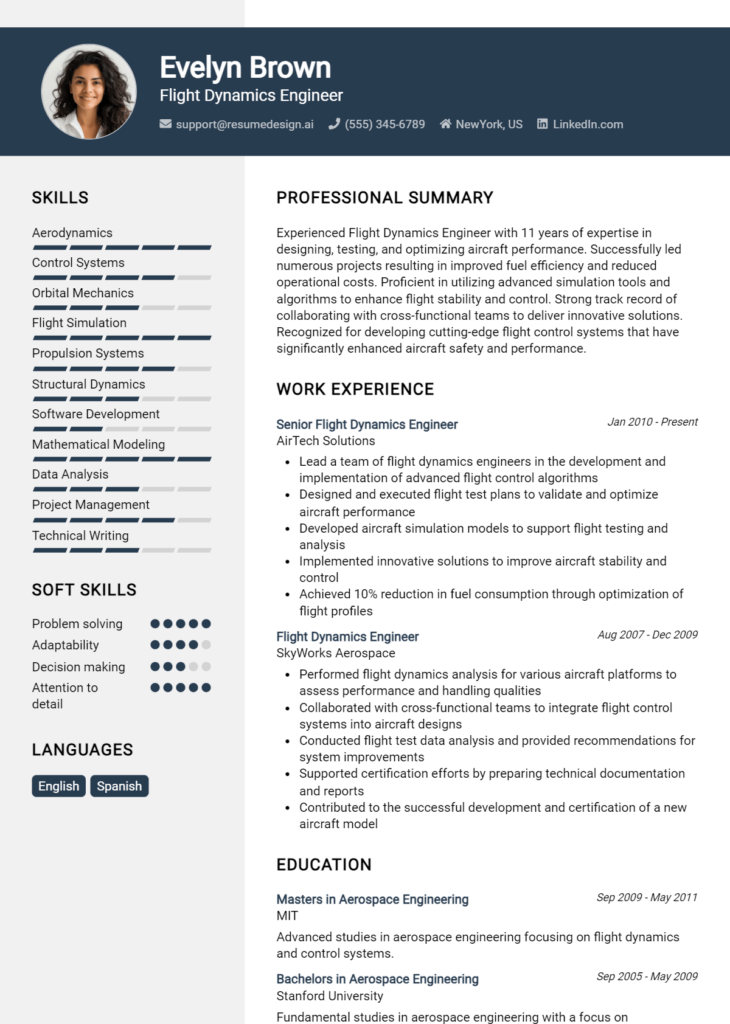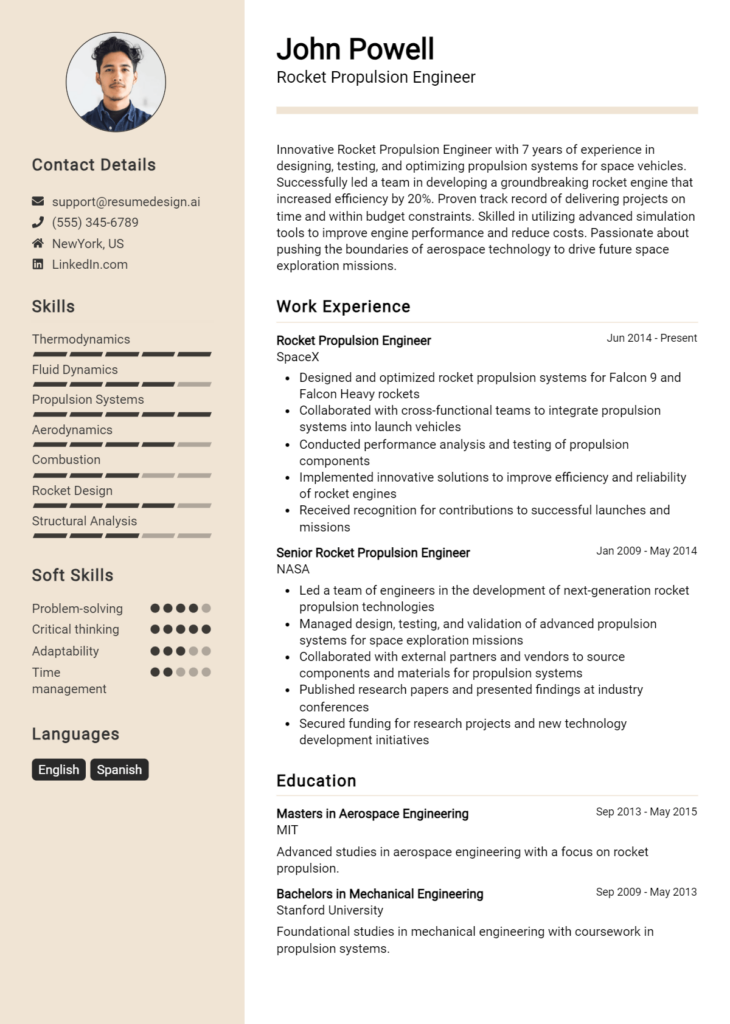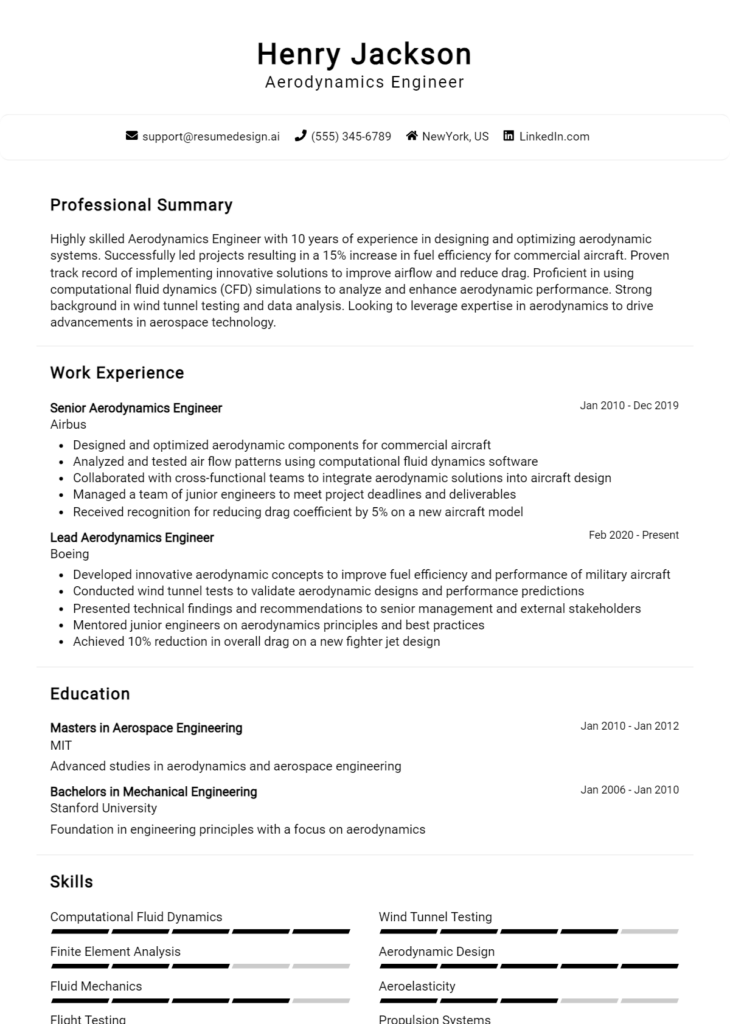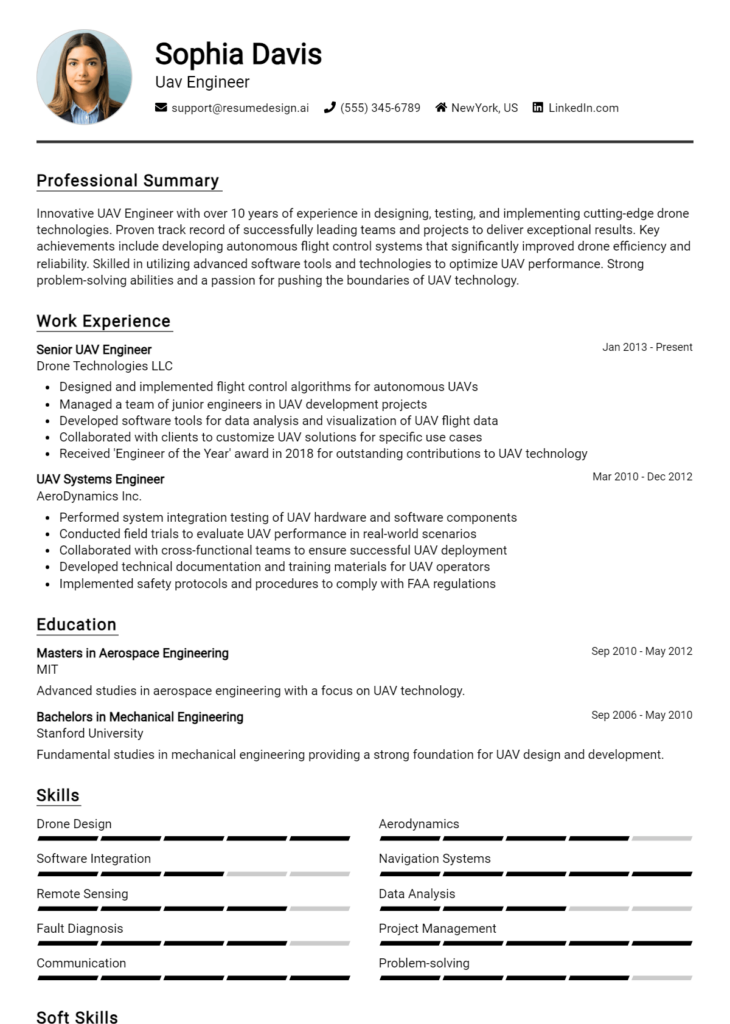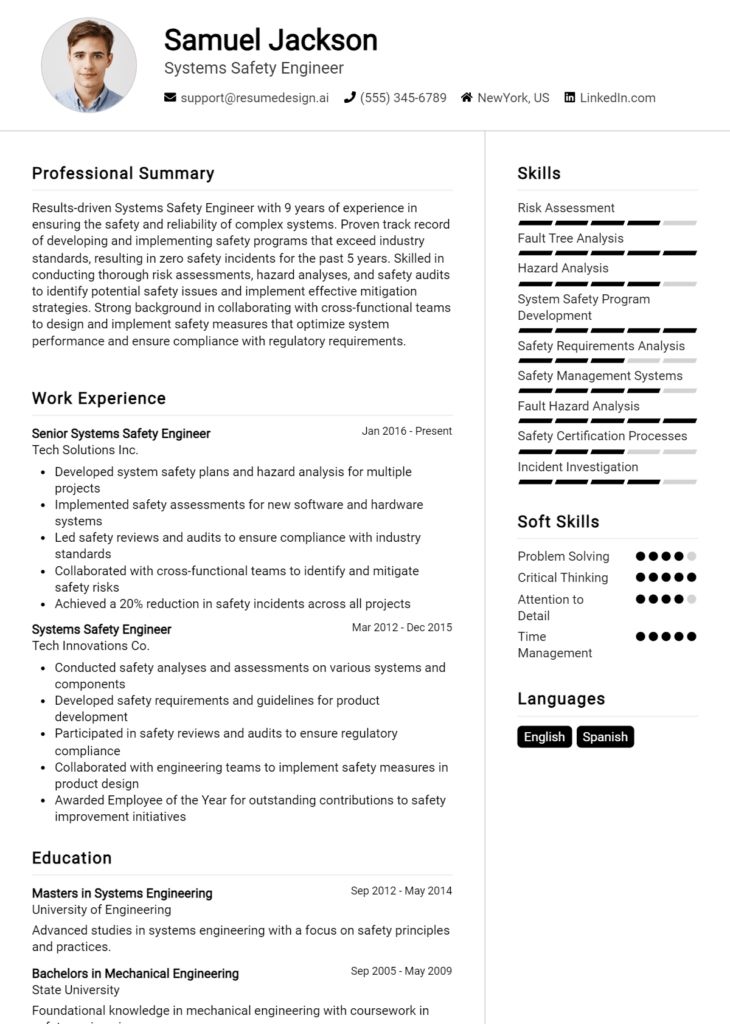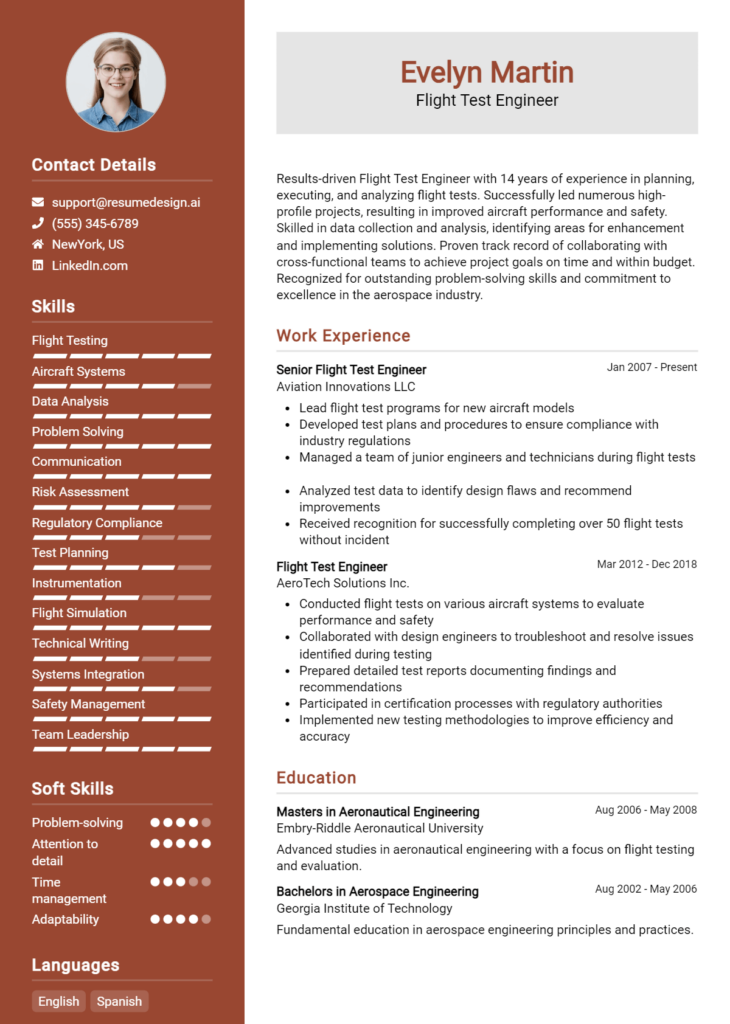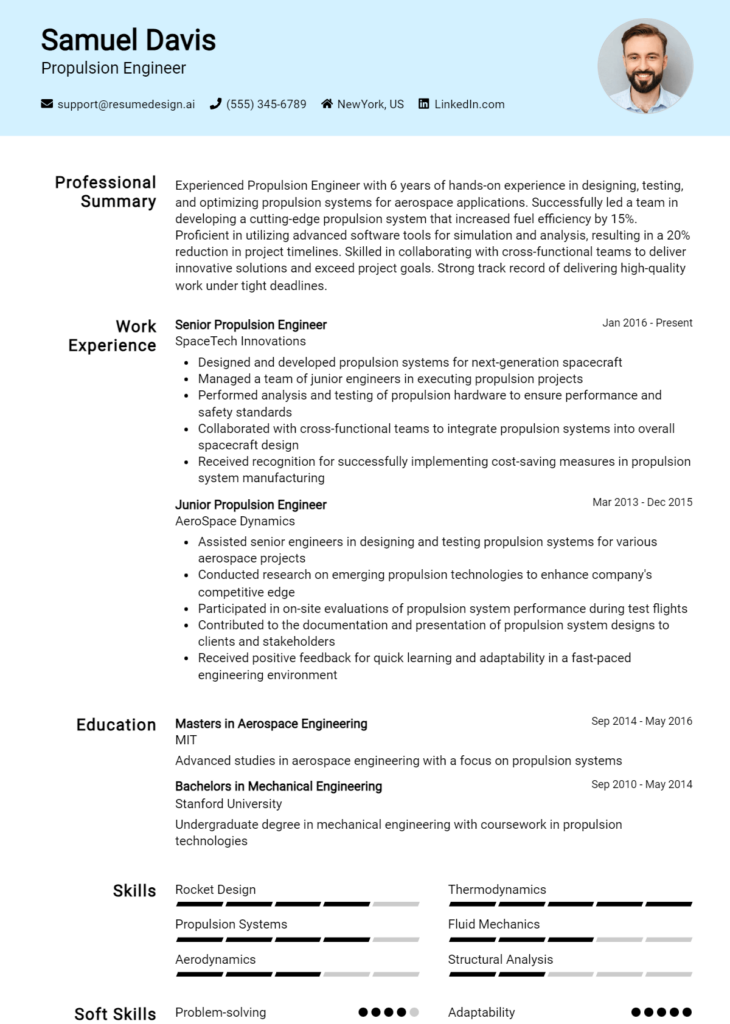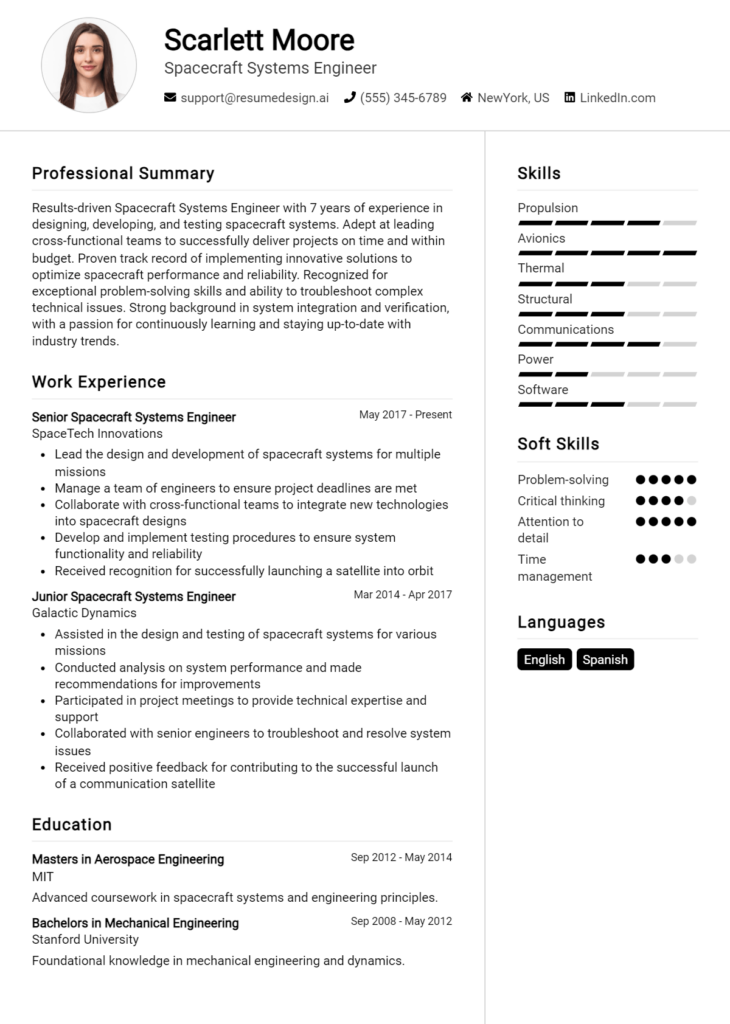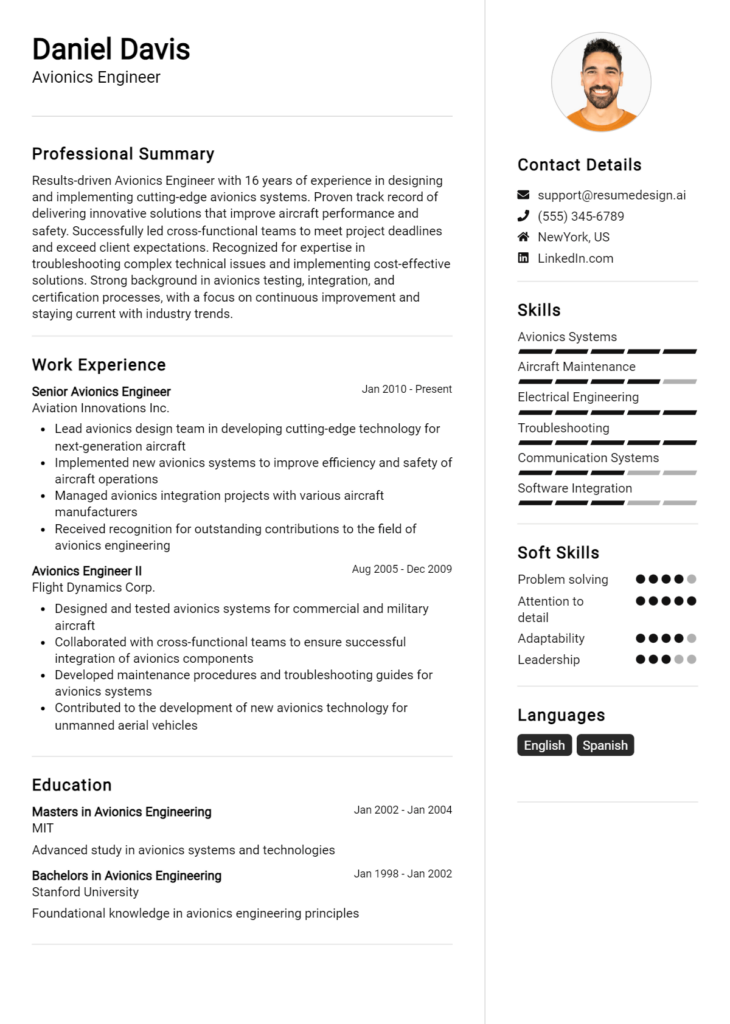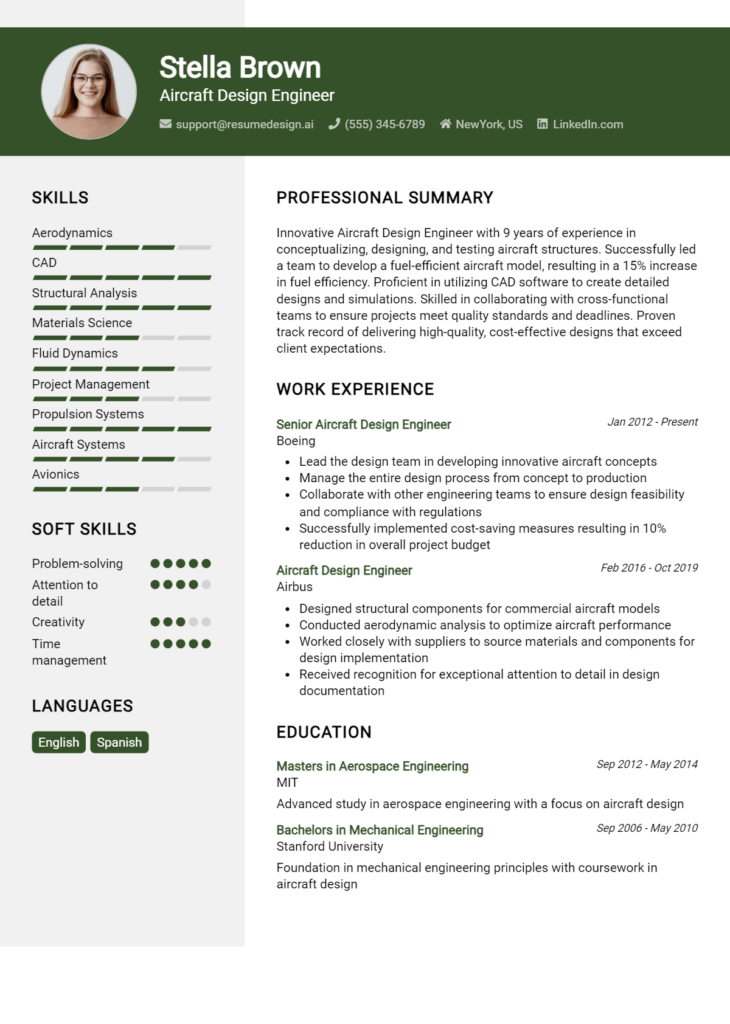Aircraft Structural Engineer Core Responsibilities
An Aircraft Structural Engineer plays a crucial role in the design, analysis, and maintenance of aircraft structures, ensuring safety and performance. This professional collaborates with various departments, including manufacturing, quality assurance, and aerodynamics, to address complex challenges. Essential skills include advanced technical knowledge, operational insight, and strong problem-solving abilities. These competencies are vital for achieving organizational goals in aviation safety and efficiency. A well-structured resume can effectively highlight these qualifications, showcasing the candidate's potential to contribute significantly to the team.
Common Responsibilities Listed on Aircraft Structural Engineer Resume
- Conduct structural analysis and design for aircraft components.
- Prepare and review engineering documentation and reports.
- Collaborate with cross-functional teams to resolve design issues.
- Perform stress testing and failure analysis on structures.
- Ensure compliance with industry standards and regulations.
- Develop and implement maintenance and inspection programs.
- Utilize computer-aided design (CAD) software for modeling.
- Provide technical support during manufacturing processes.
- Conduct risk assessments and recommend mitigation strategies.
- Participate in design reviews and safety assessments.
- Maintain up-to-date knowledge of materials and technologies.
- Assist in the development of project timelines and budgets.
High-Level Resume Tips for Aircraft Structural Engineer Professionals
In the competitive field of aircraft structural engineering, a well-crafted resume is essential for making a strong first impression on potential employers. Your resume serves as your personal marketing tool, showcasing not only your technical skills and qualifications but also your unique achievements in the industry. Because it is often the first document a hiring manager reviews, it must effectively reflect your expertise and demonstrate your value as a candidate. This guide will provide practical and actionable resume tips specifically tailored for Aircraft Structural Engineer professionals, helping you stand out in a crowded job market.
Top Resume Tips for Aircraft Structural Engineer Professionals
- Tailor your resume to the specific job description by incorporating relevant keywords and phrases used in the posting.
- Showcase relevant experience prominently, emphasizing your roles in aircraft design, analysis, and structural integrity assessments.
- Quantify your achievements with metrics, such as improvements in safety ratings or reductions in project timelines and costs.
- Highlight industry-specific skills, such as proficiency in CAD software, knowledge of materials science, and familiarity with aviation regulations.
- Include certifications and licenses that are relevant to the field, such as Professional Engineer (PE) status or specialized training in aircraft systems.
- Keep the format clean and professional, using clear headings and bullet points to enhance readability and organization.
- Incorporate a summary statement that captures your key qualifications and sets the tone for the rest of your resume.
- Demonstrate continuous learning by listing relevant professional development courses, workshops, or conferences attended.
- Provide specific examples of problem-solving skills, detailing challenges you faced and the innovative solutions you implemented.
By implementing these tips, you can significantly increase your chances of landing a job in the Aircraft Structural Engineer field. A well-structured and targeted resume not only showcases your technical competencies but also highlights your commitment to excellence and innovation, making you a compelling candidate for prospective employers.
Why Resume Headlines & Titles are Important for Aircraft Structural Engineer
In the competitive field of aircraft engineering, a well-crafted resume headline or title is crucial for standing out to hiring managers. For an Aircraft Structural Engineer, a strong headline serves as an immediate introduction that encapsulates key qualifications and expertise in a concise yet impactful way. It not only grabs attention but also provides a snapshot of the candidate’s capabilities, aligning them directly with the requirements of the job. A compelling headline can set the tone for the rest of the resume, making it essential for candidates to ensure that it is both relevant and representative of their skills and experience in the aviation sector.
Best Practices for Crafting Resume Headlines for Aircraft Structural Engineer
- Keep it concise: Aim for a headline that is brief yet descriptive, ideally one sentence or a short phrase.
- Make it role-specific: Use terminology that reflects the specific requirements of the Aircraft Structural Engineer position.
- Highlight key strengths: Focus on your most relevant skills, qualifications, or experiences that align with the job description.
- Use powerful adjectives: Incorporate strong adjectives that convey expertise and professionalism.
- Avoid jargon: Ensure that your headline is easily understandable and avoids overly technical language that may confuse hiring managers.
- Be authentic: Reflect your true experience and skills without exaggeration to maintain credibility.
- Tailor for each application: Customize your headline for each job application to better align with the specific role and company.
- Include measurable achievements: If possible, reference quantifiable accomplishments to provide concrete evidence of your capabilities.
Example Resume Headlines for Aircraft Structural Engineer
Strong Resume Headlines
Innovative Aircraft Structural Engineer with 10+ Years in Design and Analysis
Experienced Aerospace Engineer Specializing in Composite Materials and Structural Integrity
Licensed Aircraft Structural Engineer with Proven Track Record in Airframe Optimization
Detail-Oriented Structural Engineer with Expertise in FAA Compliance and Safety Standards
Weak Resume Headlines
Engineer Looking for Job
Experienced Professional in Engineering
Aircraft Engineer
Strong headlines are effective because they immediately communicate the candidate’s specific expertise and experience, allowing hiring managers to quickly assess their suitability for the role. They utilize relevant keywords and provide a clear picture of the candidate’s strengths, making them memorable. On the other hand, weak headlines tend to be vague and generic, lacking the specificity and impact needed to capture attention. Such headlines fail to convey a clear message about the candidate's qualifications, making it difficult for hiring managers to recognize their potential fit for the position.
Writing an Exceptional Aircraft Structural Engineer Resume Summary
A resume summary is a crucial component for an Aircraft Structural Engineer as it serves as the first impression to hiring managers, effectively setting the tone for the rest of the application. A strong summary quickly captures attention by succinctly showcasing key skills, relevant experience, and notable accomplishments that align with the job role. It is essential for this summary to be concise and impactful, tailored specifically to the position being applied for, thereby increasing the chances of standing out in a competitive job market.
Best Practices for Writing an Aircraft Structural Engineer Resume Summary
- Quantify Achievements: Use numbers to highlight your accomplishments, such as percentage improvements in project efficiency or cost savings.
- Focus on Relevant Skills: Highlight specific technical skills and competencies that are directly applicable to the role.
- Tailor to the Job Description: Customize your summary to reflect the requirements and priorities outlined in the job posting.
- Use Action Verbs: Begin sentences with strong action verbs to convey a sense of proactivity and impact.
- Keep It Concise: Aim for 2-4 sentences that deliver your value proposition clearly and effectively.
- Highlight Industry Knowledge: Mention specific industry standards or regulations that you are familiar with to demonstrate your expertise.
- Showcase Team Collaboration: Emphasize your ability to work in teams, especially on cross-functional projects, as collaboration is key in engineering roles.
- Include Certifications: If applicable, mention relevant certifications that enhance your qualifications, such as those from aviation authorities.
Example Aircraft Structural Engineer Resume Summaries
Strong Resume Summaries
Detail-oriented Aircraft Structural Engineer with over 7 years of experience in designing and analyzing aircraft components, achieving a 30% reduction in material costs through innovative design modifications. Proficient in using CATIA and ANSYS software, with a strong focus on compliance with FAA regulations.
Dynamic Structural Engineer with a proven track record of leading multi-disciplinary teams to successfully complete aircraft redesign projects on time and within budget, resulting in a 25% increase in airframe performance and reliability. Certified in Six Sigma methodologies.
Results-driven Aircraft Structural Engineer with expertise in finite element analysis and structural integrity assessments. Successfully improved structural testing protocols, leading to a 15% decrease in testing time and enhanced safety compliance across multiple aircraft models.
Weak Resume Summaries
A motivated engineer with experience in aircraft design and structural analysis. Seeking a position to utilize my skills in a reputable company.
I have worked in the aerospace field for several years and have knowledge of various engineering principles. Looking for opportunities to grow in my career.
The strong resume summaries are considered effective because they provide specific, quantifiable achievements and directly relate to the skills and experiences relevant to the Aircraft Structural Engineer role. They also demonstrate a clear understanding of industry standards and showcase the candidate's value to potential employers. In contrast, the weak summaries lack specificity, fail to highlight measurable outcomes, and come across as generic, making them less impactful in attracting the attention of hiring managers.
Work Experience Section for Aircraft Structural Engineer Resume
The work experience section of an Aircraft Structural Engineer resume is crucial as it serves as a comprehensive showcase of the candidate’s technical skills, leadership capabilities, and their ability to deliver high-quality products in a demanding industry. This section provides potential employers with insights into the applicant’s hands-on experience, highlighting their proficiency in structural analysis, design, and compliance with aviation regulations. Furthermore, quantifying achievements and aligning past experiences with industry standards demonstrate a candidate's direct impact on previous projects, making them a more attractive hire.
Best Practices for Aircraft Structural Engineer Work Experience
- Use specific technical terminology relevant to aircraft structural engineering to demonstrate expertise.
- Quantify achievements with metrics, such as percentage improvements in safety, cost savings, or project completion times.
- Highlight leadership roles in team projects to showcase management skills and collaboration.
- Include relevant software and tools used in structural analysis and design.
- Align experience descriptions with industry standards and regulations to enhance credibility.
- Focus on results-oriented statements that reflect the impact of your work on the organization.
- Utilize action verbs to convey a sense of proactivity and engagement in projects.
- Tailor the work experience section to the specific job application, emphasizing the most relevant experiences.
Example Work Experiences for Aircraft Structural Engineer
Strong Experiences
- Led a cross-functional team of 10 engineers in the successful redesign of wing structures, resulting in a 15% increase in aerodynamic efficiency and a $2 million cost reduction.
- Managed the structural analysis and testing of a new aircraft model, achieving full compliance with FAA regulations on the first submission.
- Developed a predictive maintenance program that decreased unscheduled maintenance events by 30%, enhancing fleet reliability and operational efficiency.
- Implemented advanced finite element analysis (FEA) techniques that improved the accuracy of stress testing by 25%, leading to enhanced structural integrity assessments.
Weak Experiences
- Worked on various projects related to aircraft structures.
- Assisted in some testing and analysis tasks.
- Participated in team meetings and discussions about structural engineering topics.
- Handled documentation and reports for engineering projects.
The examples labeled as strong demonstrate specific achievements and contributions that are quantifiable and impactful, showcasing the candidate's technical leadership and collaborative skills. In contrast, the weak experiences lack detail and measurable outcomes, making them less compelling to potential employers. Vague statements do not convey the candidate's true level of expertise or the significance of their contributions to previous projects.
Education and Certifications Section for Aircraft Structural Engineer Resume
The education and certifications section of an Aircraft Structural Engineer resume plays a crucial role in establishing the candidate's qualifications and expertise in the field. This section not only showcases the academic background relevant to aircraft design and maintenance but also emphasizes industry-relevant certifications that demonstrate a commitment to professional development. By including pertinent coursework and specialized training, candidates can enhance their credibility and illustrate their alignment with the job role, making them more attractive to potential employers. Continuous learning efforts signal a proactive approach to staying updated with the latest industry standards and practices, which is vital in the ever-evolving aerospace sector.
Best Practices for Aircraft Structural Engineer Education and Certifications
- Include degrees in aerospace engineering, mechanical engineering, or related fields.
- List relevant certifications such as Certified Aerospace Technician (CAT) or Structural Engineering License.
- Highlight specialized training programs or workshops related to aircraft structures.
- Provide details of relevant coursework that aligns with industry standards.
- Use clear formatting to make the information easy to read and navigate.
- Prioritize recent and advanced credentials over outdated qualifications.
- Consider including continuing education courses that demonstrate ongoing professional development.
- Tailor the section to match the specific requirements of the job being applied for.
Example Education and Certifications for Aircraft Structural Engineer
Strong Examples
- Bachelor of Science in Aerospace Engineering from the University of Michigan, 2021
- Certified Aerospace Technician (CAT) from the National Institute for Aviation Research, 2022
- Advanced Composites Training Certificate from the Aircraft Maintenance Engineering School, 2023
- Relevant Coursework: Aerodynamics, Structural Dynamics, and Aircraft Materials Science
Weak Examples
- Bachelor of Arts in History, University of Florida, 2010
- Outdated certification in Aircraft Maintenance, obtained in 2005
- High School Diploma with no relevant coursework listed
- General Engineering Certificate without specific focus on aerospace applications
The examples considered strong are directly relevant to the role of an Aircraft Structural Engineer, showcasing advanced degrees, current certifications, and specialized training that align with industry standards. In contrast, the weak examples reflect outdated or unrelated educational qualifications that do not adequately convey the candidate's suitability for the position. Including strong examples enhances credibility and aligns the candidate with the expectations of potential employers, while weak examples detract from the overall impression of the candidate's qualifications.
Top Skills & Keywords for Aircraft Structural Engineer Resume
The role of an Aircraft Structural Engineer is critical in ensuring the safety, integrity, and efficiency of aircraft design and manufacturing. A well-crafted resume that highlights the necessary skills can significantly enhance an applicant's chances of landing an interview. Skills not only demonstrate a candidate's qualifications but also their ability to tackle the unique challenges faced in the aerospace industry. Employers look for a combination of hard and soft skills that reflect both technical expertise and interpersonal abilities. By showcasing these skills effectively, candidates can convey their readiness to contribute to a dynamic team in a high-stakes environment.
Top Hard & Soft Skills for Aircraft Structural Engineer
Soft Skills
- Strong analytical thinking
- Effective communication
- Team collaboration
- Problem-solving abilities
- Attention to detail
- Time management
- Adaptability
- Leadership skills
- Creativity and innovation
- Critical thinking
Hard Skills
- Proficiency in CAD software (e.g., CATIA, SolidWorks)
- Knowledge of materials science and properties
- Experience with structural analysis tools (e.g., ANSYS)
- Understanding of aerospace regulations and standards (e.g., FAA, EASA)
- Proficient in finite element analysis (FEA)
- Familiarity with manufacturing processes and techniques
- Ability to conduct stress analysis and fatigue testing
- Skills in project management software
- Understanding of aircraft systems and design principles
- Competence in conducting risk assessments and safety evaluations
For more insights on essential skills and how to highlight your work experience, consider exploring additional resources to strengthen your resume.
Stand Out with a Winning Aircraft Structural Engineer Cover Letter
Dear Hiring Manager,
I am writing to express my interest in the Aircraft Structural Engineer position at [Company Name], as advertised on [where you found the job listing]. With a degree in Aerospace Engineering and over [X years] of hands-on experience in aircraft design and structural analysis, I am excited about the opportunity to contribute my expertise to your esteemed team. My background in both commercial and military aviation projects has equipped me with a robust understanding of structural integrity, materials science, and regulatory compliance, all of which are crucial for ensuring the safety and performance of aircraft.
In my previous role at [Previous Company Name], I led a team responsible for the redesign of key structural components for an aircraft model, which resulted in a 15% reduction in weight while maintaining compliance with FAA regulations. Utilizing advanced simulation tools such as ANSYS and CATIA, I performed detailed stress analysis and developed innovative solutions that enhanced overall aircraft performance. My collaborative approach allowed me to work effectively with cross-functional teams, including design, manufacturing, and testing, ensuring that all aspects of the project met operational requirements and timelines.
I am particularly drawn to [Company Name] because of its commitment to innovation and excellence in the aerospace industry. I am eager to bring my skills in structural analysis, project management, and problem-solving to your team. I am confident that my proactive mindset and dedication to quality will make a positive impact on your projects. I look forward to the opportunity to discuss how my experience and vision align with the goals of [Company Name].
Thank you for considering my application. I am looking forward to the possibility of contributing to your dynamic team and am available at your earliest convenience for an interview. Please feel free to contact me at [Your Phone Number] or [Your Email Address].
Best regards,
[Your Name]
[Your Address]
[City, State, Zip]
[Your LinkedIn Profile or Professional Website]
Common Mistakes to Avoid in a Aircraft Structural Engineer Resume
When applying for a position as an Aircraft Structural Engineer, your resume serves as a critical first impression. Crafting a compelling resume can be challenging, and many candidates inadvertently make mistakes that can hinder their chances of landing an interview. Understanding and avoiding these common pitfalls can significantly enhance your application. Below are some mistakes to watch out for when creating your resume:
Lack of Relevant Keywords: Failing to incorporate industry-specific terminology and keywords can result in your resume being overlooked by applicant tracking systems (ATS) that many employers use.
Overly Technical Language: While technical knowledge is crucial, using excessive jargon can confuse hiring managers who may not be familiar with the intricacies of aircraft structural engineering.
Inadequate Focus on Achievements: Listing job responsibilities without highlighting specific achievements or contributions can make your resume less impactful. Quantifying your accomplishments with metrics can strengthen your application.
Neglecting Soft Skills: Focusing solely on technical skills without mentioning soft skills, like teamwork and communication, may give an incomplete picture of your capabilities as an engineer.
Poor Formatting: Using inconsistent fonts, sizes, or layouts can make your resume difficult to read. A clean, organized format helps convey professionalism and attention to detail.
Too Much Length: Including every detail of your career can lead to a lengthy resume that overwhelms the reader. Aim for a concise presentation of your most relevant experiences and skills.
Ignoring Tailoring: Submitting a generic resume for every application can be detrimental. Tailoring your resume to align with the specific job description shows that you are genuinely interested in the position.
Spelling and Grammar Mistakes: Errors in spelling and grammar can undermine your credibility. Proofreading and using tools to check for mistakes is essential to ensure a polished final product.
Conclusion
As an Aircraft Structural Engineer, your role is critical in ensuring the safety, reliability, and performance of aircraft structures. You are tasked with designing, analyzing, and testing various components, which requires a strong foundation in engineering principles, materials science, and a keen understanding of industry regulations. Additionally, effective communication and collaboration with multidisciplinary teams are essential to successfully bring projects to fruition.
In the competitive field of aerospace engineering, having a standout resume is crucial. It should reflect not only your technical skills and experience but also your achievements and contributions to past projects. Tailoring your resume to highlight relevant expertise and aligning it with the specific requirements of job postings can significantly increase your chances of landing interviews.
To enhance your resume, consider utilizing available resources that can streamline the process. Explore resume templates to find designs that suit your professional style. Use the resume builder for a user-friendly way to create a polished document that showcases your qualifications. Additionally, reviewing resume examples can provide inspiration and ideas on how to effectively present your background. Don’t forget about a compelling cover letter—check out the cover letter templates available to ensure you make a strong first impression.
Take the time to review and refine your Aircraft Structural Engineer resume today, and position yourself as a top candidate in this dynamic field!

